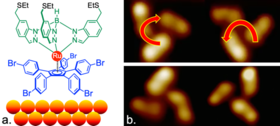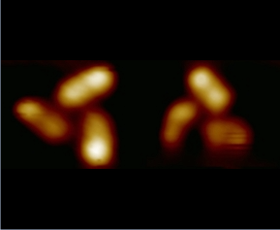Materials Science 2019/09/05
With the celebration of the 50th anniversary of the moon landing this year, it could be argued that the greatest science of the 20th Century was about big machines that could travel the universe. The rise of nanotechnology is suggesting that the 21th Century will be dedicated to much smaller machines that can travel inside the smallest spaces including human cells. Researchers at Nara Institute of Science and Technology (NAIST), Japan, in partnership with research teams in the University Paul Sabatier (France) and Prof. Saw-Wai Hla in Ohio University (USA), report in Nature Communications the latest nanomachine, a propeller that can rotate at will in both clockwise and counterclockwise directions and transfer this motion to another molecule like gears.
Nature has proven exceptional at designing similar machines by using molecules that can convert optical, chemical or electrical energy into interactions with the surface to generate motion. "For many nanomachines, we look at nature as our model. There are many examples of propellers with which organisms move in dynamic environments. Surprisingly, these natural nanomachines take the shape of large-scale propellers," says NAIST Professor Gwénaël Rapenne, who contributed to the new study.
Consistently, the propeller designed by Rapenne and his colleagues consists of three components: three blades each composed of an indazole, a stator consisting of five phenyl groups, and a ruthenium atom that binds to the two and allow the rotation like a ball bearing.
One of the major differences is the conditions in which artificial nanopropellers work. Where natural nanomachines tend to work in environments comfortable for life, artificial nanomachines can work in much harsher conditions. Rapenne demonstrates this point by attaching his machine to a gold surface and observing that some begin swirling at extremely cold temperatures (near -200 oC). At the same time no propellers move at -275 oC, verifying their ability to convert thermal energy into movement.
The propellers also showed the capacity to rotate in different directions in a controlled manner, but never to switch directions. This was the result of how the propeller was attached to the gold surface, which caused a slight tilt in the stator. The direction of the tilt determined the direction of the spin. This feature is reminiscent to macroscopic propellers we see in the real world.
"The stator acts as a ratchet-shaped gear that imposes a unidirectional rotation," notes Rapenne.
This is not the first time Rapenne has used gold to prove the capabilities of his nanomachines. Two years ago, he and colleagues organized the world's first nanocar competition using gold tracks. While he does not expect to follow that effort with the first nano single propeller competition, he does believe the new machines will serve an important purpose in the nanoworld.
"Our propellers can displace nearby molecules, showing that they can be used to move molecular loads for faster transfer of energy or information," he says.
###
Resource
- Title: A chiral molecular propeller designed for unidirectional rotations on a surface
- Authors: Yuan Zhang, Jan Patrick Calupitan, Tomas Rojas, Ryan Tumbleson, Guillaume Erbland, Claire Kammerer, Tolulope Michael Ajayi, Shaoze Wang, Larry A. Curtiss, Anh T. Ngo, Sergio E. Ulloa, Gwénaël Rapenne & Saw Wai Hla
- Journal: Nature Communications
- DOI: 10.1038/s41467-019-11737-1







